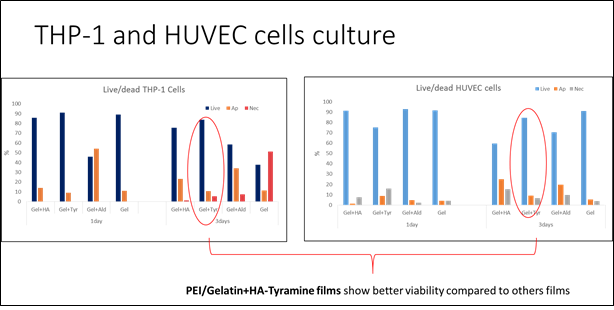Chronic inflammation and the pathological changes in the microenvironment can be detrimental for the long term functionality of the implanted materials/tissues. Innovative approaches for controlling the immune response are of highest priority for the improvement of such implant. The main objective of this work is the development of a thin film acting as an adhesive system which is able to release anti-inflammatory and angiogenic cytokines to control macrophage phenotype that will prevent infections and also help healing process and tissue regeneration around implants. To this end we have designed a modular ECM-mimicking thin film designed to be loaded with bioactive agent needed for macrophages and other cell types for healing such as fibroblasts and vascular endothelial cells.
The films were fabricated with a mix with gelatin type B and hyaluronic acid derivatives (HA-tyramine and HA-Aldehyde) with a spin coating method[1]. The cooling and the spin coating of the gelatin solution produce a homogenous film on the surface. HA conjugates present the advantage of being crosslinkable: i) HA-aldehyde can react with amino group either via formation of ionic pair or via formation of covalent imine bond –CH=N- between aldehyde and amine groups; ii) HA-tyramine crosslinking is based on dimerization of tyramine to dityramine by horseradish peroxidase mediated reaction. Moreover, gelatin is also crosslinked enzymatically with transglutaminase (TGA). Our current focus is to use the controlled release capacities for the delivery of immunomodulatory cytokines such as Interleukin 4 (IL-4) and quantification of its effect on primary macrophages. IL-4 is a key cytokine in type 2 immunity, which is essential for wound healing and allergy.
The gelatin films (gelatin; gelatin/HA; gelatin/HA-Tyramine and gelatin/HA-Aldehyde) are not stable more than 3 days. The film Gelatin/HA-Tyramine presents the best stability after 7 days of incubation in PBS. The THP-1 and HUVEC cells were seeded on Gelatin/HA’s samples in order to select the best film composition for cell viability. Both kind of cells attached on the films and were viable after 1 day of culture. In the case of THP-1, after 3 days, it is observed that more live cells were present on Gel+Tyr films, compared to Gel+Ald and Gel.

In summary, the gelatin/HA-tyramine, presents a very high stability (75% of remaining film after 21 days), which is related to the fact that the film is double crosslinked. Furthermore, the metabolic activity of macrophages cultured on the top of the film (2D culture) and encapsulated in gelatin hydrogel deposited on the top of the film (3D culture) is improved in the presence of IL-4 releasing system in particular for long term culture.
In conclusion, the film system consisting of gelatin and acid - tyramine hyaluronic derivative shows promise as a bioactive agent reservoir. Furthermore, once functionalized with IL-4, it presents a potential for a local prevention of inflammation and induction of healing.
References:
[1] Barthes J, Vrana NE, Özçelik H, Gahoual R, François YN, Bacharouche J, et al. Priming cells for their final destination: microenvironment controlled cell culture by a modular ECM-mimicking feeder film. Biomaterials science 2015;3:1302-11.